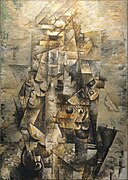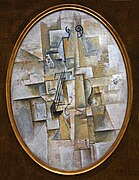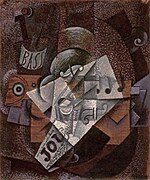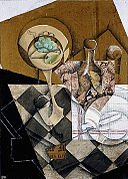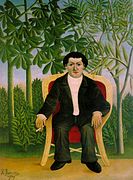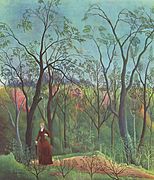Wilhelm Uhde

Wilhelm Uhde (28 October 1874, Friedeberg, Province of Brandenburg (now Poland) – 17 August 1947, Paris) was a German art collector, dealer, author, and critic, an early collector of modernist painting, and a significant figure in the career of Henri Rousseau.
Biography
[edit]
Born into a Jewish family,[1] Uhde studied law in Dresden but switched to art history, studying in Munich and Florence before moving to Paris in 1904. He purchased his first Picasso in 1905, and was one of the first collectors of the Cubist paintings of Pablo Picasso and Georges Braque. He met Robert Delaunay, Sonia Terk, and Henri Rousseau in 1907, and opened his art gallery in 1908, rue Notre-Dame-des-Champs (Paris) where he exhibited Georges Braque, Jean Metzinger, Sonia Delaunay, André Derain, Raoul Dufy, Auguste Herbin, Jules Pascin, and Pablo Picasso.[2][3] Uhde commissioned Picasso to paint his portrait (1910) and produced the first monograph on Rousseau in 1911.[4]


Uhde and Sonia Terk married in 1908 (London), reportedly a marriage of convenience which masked his homosexuality. They divorced in 1910 and Terk married Robert Delaunay.[4]
At the outbreak of World War I, many German nationals living in France had their possessions sequestered by the French state. As a result, Uhde's collection (including works by Georges Braque, Raoul Dufy, Juan Gris, Auguste Herbin, Marie Laurencin, Fernand Léger, Jean Metzinger, Pablo Picasso, Jean Puy, and Henri Rousseau) was confiscated in 1914 and sold by the government in a series of auctions at the Hôtel Drouot in 1921.[5][6]
From 1919 to 1920, Uhde worked with Helmut Kolle and lived with him in Chantilly, France. Uhde became active as a pacifist in Weimar Germany, but returned to France in 1924, moving back to Chantilly in 1927. A Jew, he spent the Second World War in hiding in southern France, at one point helped by the art critic and resistance leader Jean Cassou.
The Sacred Heart painters
[edit]Uhde is also known as the principal organiser of the first Naive Art exhibition, which took place in Paris in 1928. The participants were Henri Rousseau, André Bauchant, Camille Bombois, Séraphine Louis, and Louis Vivin, known collectively as the Sacred Heart painters. Séraphine Louis who had been Uhde's housecleaner artwork was discovered by Uhde who then sponsored her from 1912 to 1930.
Writings
[edit]- Picasso et la tradition française, Paris : Les Quatre Chemins, 1928
- Cinq maîtres primitifs, Paris, 1949
- Von Bismarck bis Picasso: Erinnerungen und Bekenntnisse (1938) recent editions:
- Uhde, Wilhelm (2010). Von Bismarck bis Picasso: Erinnerungen und Bekenntnisse. Römerhof Verlag. ISBN 978-3-905894-06-6.
- Uhde, Wilhelm (2002). De Bismarck à Picasso. ISBN 2-910342-22-0.
Legacy
[edit]A significant part of Uhde's life story is told in the 2008 French film Séraphine by director Martin Provost, focusing on the encounter and subsequent role of Séraphine Louis in his life and he in hers. The film won seven César Awards, including Best Film.
Works from the collection of Wilhelm Uhde
[edit]-
Jean Metzinger, 1906, La danse (Bacchante), oil on canvas, 73 x 54 cm. Last known location Kröller-Müller Museum, Otterlo, Netherlands
-
Georges Braque, 1909–10, La guitare (Mandora, La Mandore), oil on canvas, 71.1 x 55.9 cm, Tate Modern, London
-
Georges Braque, 1911–12, Figure, L'homme à la guitare (Man with a Guitar), oil on canvas, 116.2 x 80.9 cm (45.75 x 31.9 in), Museum of Modern Art, New York
-
Georges Braque, 1913, Nature morte (Fruit Dish, Ace of Clubs), oil, gouache and charcoal on canvas, 81 x 60 cm (31.8 x 23.6 in), Musée National d'Art Moderne, Centre Georges Pompidou, Paris
-
Pablo Picasso, 1909, Buste de femme (Femme en vert, Femme assise), oil on canvas, 100.3 x 81.3 cm, Van Abbemuseum, Netherlands
-
Pablo Picasso, 1909–10, Figure dans un Fauteuil (Seated Nude, Femme nue assise), oil on canvas, 92.1 x 73 cm, Tate Modern, London
-
Pablo Picasso, 1910, La Joueuse de Mandoline (Girl with a Mandolin, Fanny Tellier), oil on canvas, 100.3 x 73.6 cm, Museum of Modern Art, New York
-
Pablo Picasso, 1911–12, Violon (Violin), oil on canvas, 100 x 73 cm (oval), Kröller-Müller Museum, Otterlo, Netherlands
-
Pablo Picasso, 1913, Bouteille, clarinette, violon, journal, verre, 55 x 45 cm
-
Juan Gris, 1914, Le Compotier (The Fruit Bowl), chalk and oil on canvas, 92 x 65 cm, Kröller-Müller Museum, Otterlo, Netherlands
-
Raoul Dufy, 1914, Le Cavalier arabe (Le Cavalier blanc), oil on canvas, 66 x 81 cm, Musée d'Art Moderne de la Ville de Paris
-
Auguste Herbin, 1911, Le pont de fer (Iron Bridge), oil on canvas, 63.5 x 80 cm
-
Henri Rousseau, 1909, Portrait of Joseph Brummer, oil on canvas, 116 x 88.5 cm (45.7 x 34.8 in), private collection
-
Henri Rousseau, 1886, La Femme en rouge dans le forêt (Am Waldrand), oil on canvas, 70 x 60.5 cm, Kunsthaus Zürich
References
[edit]- ^ The amazing life story of Wilhelm Uhde
- ^ Queer places
- ^ MAM, Musée d'Art Moderne de la Ville de Paris, Paris 1937, L'Art Indépendant, ex. cat. ISBN 2-85346-044-4, Paris-Musées, 1987, P. 188
- ^ a b "Dictionary of Art Historians".
- ^ Vente de biens allemands ayant fait l'objet d'une mesure de Séquestre de Guerre: Collection Uhde. Paris, 30 May 1921
- ^ Malcolm Gee, "Dealers, Critics and Collectors of Modern Painting; Aspects of the Parisian Art Market Between 1910 and 1930", Courtauld PhD Dissertation 1977, p25
- 1874 births
- 1947 deaths
- People from Strzelce-Drezdenko County
- People from the Province of Brandenburg
- German art critics
- 19th-century German Jews
- German art collectors
- French art collectors
- 19th-century art collectors
- 20th-century art collectors
- Jewish art collectors
- Naïve art
- Modern art
- Emigrants from the German Empire to France



